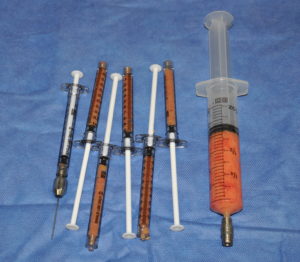Scleroderma is a collection of autoimmune connective tissue diseases that are characterized by chronic inflammation and tissue atrophy. In general terms, there is localized scleroderma and systemic sclerosis whose main difference is as their names suggest. The exact mechanism as to why it occurs is not known although much of the cellular responses that leads to the disease has been described. Ultimately the inflammatory response leads to vascular compromise and eventually to skin fibrosis. (skin thickening, dry skin and loss of hair follicles)

In the December 2019 issue of the journal Plastic and Reconstructve Surgery an article was published entitled ‘Fat Grafting for the Treatment of Scleroderma’. The authors describe the potential therapeutic effects of adipocytes and stromal vascular fraction cells that comprise injected fat. Such fat grafts have a large number of potential therapeutic effects including immunomodulation, reduction of vascular inflammation, enhanced angiogenesis, reduction of fibrosis and the creation of structural support via stem cell proliferation.
The authors reviewed fifteen (15) clinical papers that have employed fat grafting in various scleroderma conditions, many of which are either case reports or retrospective case series. Such fat grafting has shown good success in contour improvement in scleroderma defects of the frontal scalp and forehead with less graft retention in the chin. Injectable fat grafting has been shown to be particularly effective in the lips and perioral region with reductions in rhytids and lip stiffness. Hand involvement responds well to fat injections with sustained reduction in hand pain and stiffness and the healing of digital ulcers.
While clinical reports/studies has shown the benefits of fat grafting in scleroderma, when to intervene is not yet known as well as how much fat to inject and how many treatments are needed. While prospective and controlled clinical studies are needed, to the scleroderma patients so affected there is no such thing as too early an intervention or too many treatments. They seek relief as soon and as often as possible. And given the lack of any known side effects of fat injections, unlike drugs, a more aggressive approach to their use in scleroderma should be considered.
Dr. Barry Eppley
Indianapolis, Indiana



